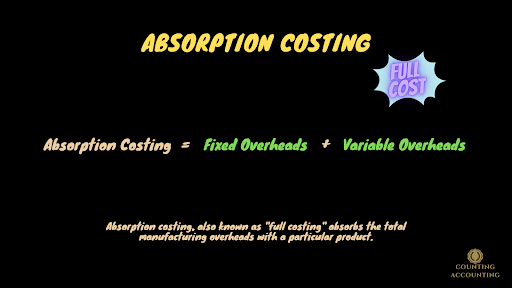Absorption Costing
What is Absorption Costing?
Absorption costing, also known as "full costing" absorbs the total manufacturing overheads with a particular product. According to the GAAP and IFRS absorption costing should be used in financial reporting externally.
What Are The Components of Absorption Costing?
Direct Materials: Direct materials are items that are directly identifiable in the finished product.
Direct Labor: Direct labor includes all the labor payments within a factory to convert raw materials into finished goods.
Variable Manufacturing Overhead: Variable overhead costs include all the costs of maintaining the manufacturing facility. variable cost varies with production volume, if production volume increases the cost increases.
Fixed Manufacturing Overhead: Fixed manufacturing costs aren't connected with the production volume. For example, Rent is a fixed cost and it doesn't depend on the production, every month a fixed amount of rent payment should be made.
selling, general and administrative expenses (SG&A) is not subject to absorption costing as these costs are period cost, not product cost. So these costs are not related to the goods.
Activity-Based Costing
Activity-based costing can be used to allocate overheads for proper inventory valuation under the absorption costing system. ABC costing system is a modern costing system with highly effective data depending processes. That's why the ABC costing system is more time-consuming and costly to implement.
Steps of Absorption Costing
Step 1. Assign Costs to Cost Pools: Cost pools are group of individual cost that is associated with a production of a product. You may divide different costs into different pools.
Step 2. Calculate Usage for Each Cost: Now you need to find out the uses of cost according to the cost driver. The uses can be determined by machine hour or labor hour.
Step 3. Calculate and Assign Costs: Divide the cost according to the allocation rate per unit of activity. This is a formula of Absorption cost per unit = (Direct Material Costs + Direct Labor Costs + Variable Manufacturing Overhead Costs + Fixed Manufacturing Overhead Costs) / Number of units produced.
A company produces 70,000 units of products. The price of each product is $100.
Costs: Direct Meterial- $30, Direct labor - $25, Manufacturing overhead - $15, Variable manufacturing overhead - $5, Fixed manufacturing overhead - $300,000.
Absorption cost per unit = {$30+$25+$15+($300,000 / $700,000)} = $60 per unit product cost.)
= $75.42
Absorption Costing vs. Variable Costing
According to the absorption costing Direct Materials, Direct Labor, Variable Manufacturing Overhead, and Fixed Manufacturing Overhead is considered as product cost. Under Variable costing only Fixed Manufacturing Overhead is considered as period cost and other costs remain the same as absorption costing.




